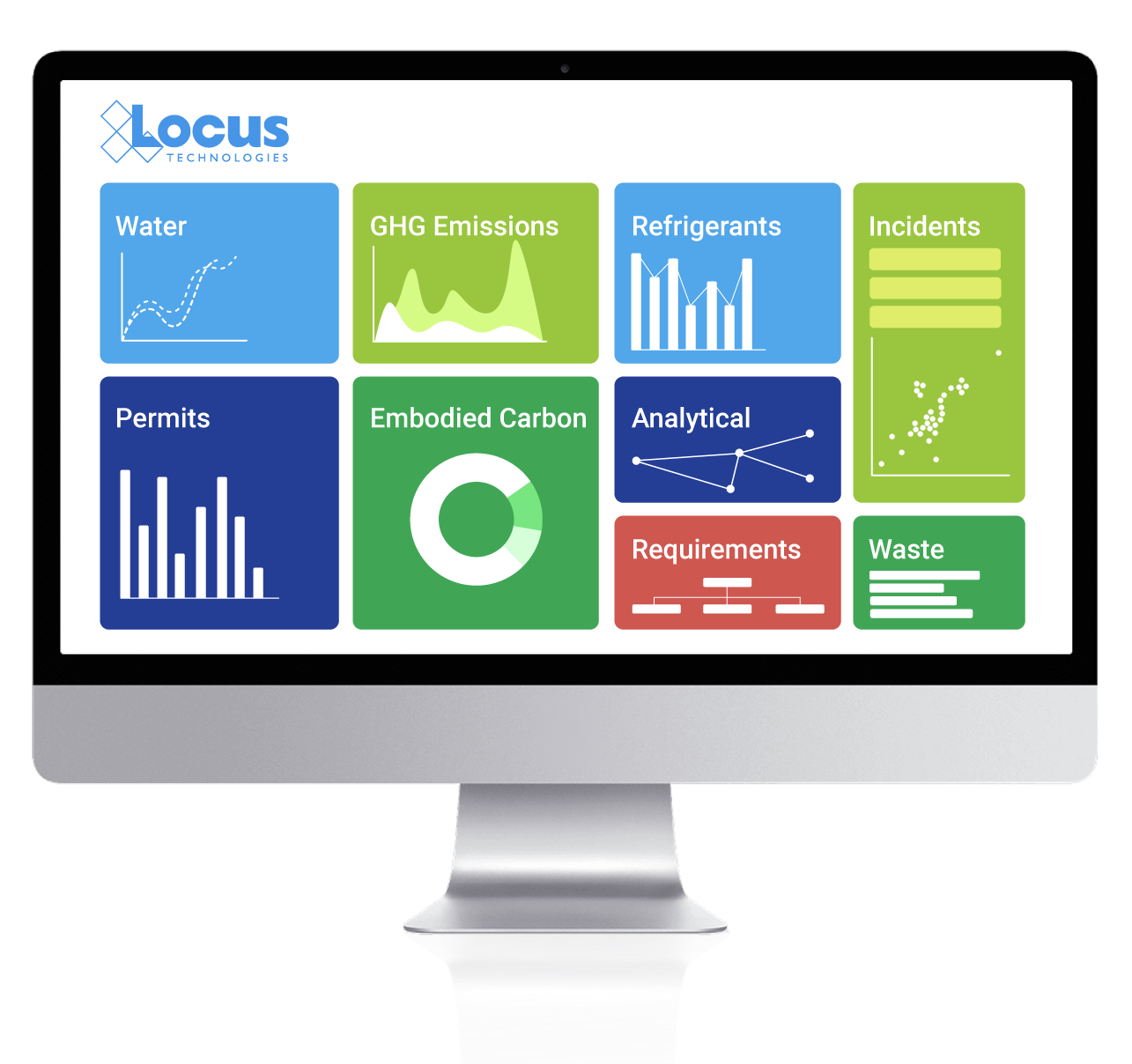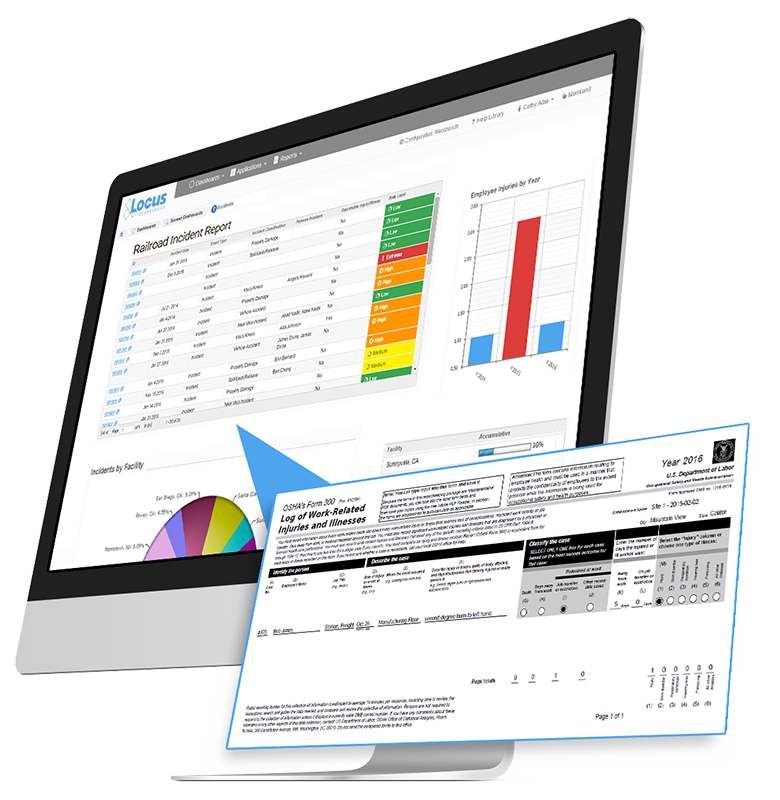Consistent UX across Locus Platform and Locus apps
Locus EHS platform is the only truly integrated platform for analytical and compliance data
Our clients have big compliance calendars, big sustainability goals, big data, and big ideas for their ideal EHS platform. Locus Platform provides the power and agility to help organizations address all that big stuff in a single source of truth.
Just as ERP platforms consolidate HR, accounting, and analytics, Locus Platform unites all EHS&S functions within One View.
Connect Locus Platform to any data source (including your ERP) and begin fulfilling your environmental compliance, water, and sustainability requirements. Add various Locus apps to tackle specific challenges, like Title V permits, waste eManifests, DMRs, or incident tracking. Or better yet: drag-and-drop Locus components to create your own apps in the system.
Locus is the only EHS platform that ticks every box in terms of security, reliability, ISO and SOC 2 alignment, and functionality, but also keeps pace with regulatory changes. Best of all: Locus is uniquely built to capitalize upon AI.
Benefits
Our clients extend Locus Platform with their favorite pre-built Locus apps… and some choose to create their own no-code apps to resolve unique business challenges.
30+ pre-built
Locus apps… and counting
10 minutes
to roll out your own app
Connects to everything
Locus software eliminates redundant data entry and data siloes. Our clients enter data once and use it repeatedly across multiple Locus apps, dashboards, and reports.
- Our RESTful APIs establish data exchanges between Locus and other enterprise products like ERP, HR, BI, GIS products, and link to regulatory content providers.
- Locus connects to mobile, SCADA, and Internet of Things (IoT) devices to accelerate field collection and gain insights from smart sensors.
- Locus supports Electronic Data Deliverables (EDD) from laboratories and Electronic Product Declarations (EPD) from materials engineers.
- Locus users store supplementary materials such as environmental assessments or photos from incidents and outfalls via built-in libraries, document management tools, or links to Microsoft SharePoint.
Accelerates the toughest work
- Whether working with kilowatt hours, parts per million, metric tons, micrograms per cubic meter, CO2e, or anything else, Locus Platform recognizes hundreds of unit-types and automatically converts data.
- Locus Platform supports hundreds of universal scientific formulas to automate complex calculations across data fields.
- Locus Platform includes powerful keyword search and SQL/HQL query engines.
- Built-in Rules and Workflow engines guide multi-step processes and automate decision-making. Power users can configure their own business logic and workflows.
- Locus Platform includes team alerts and instant messaging to facilitate real-time collaboration among colleagues.
- Locus Platform supports GIS mapping, and built-in business analytics tools can be enhanced via API with third-party tools like Tableau® and Power BI®.
- Configurable dashboards summarize critical KPIs, and reporting tools are fully auditable, role-based, and customizable.
Hosts unlimited, use case-specific Locus apps
Locus maintains an ecosystem of dozens of Locus apps, each of which resolves specific challenges for EHS&S professionals. Mix-and-match individual apps to create the ideal EHS&S solution on Locus Platform. Or choose from clusters of related Locus apps, including the Water Data Collection, Compliance Collection, Sustainability Collection, and the Analytical Data Collection.
Powered by sophisticated architecture
Locus software easily scales to fit the smallest water utility and the largest chemical manufacturer. How do we do it?
- Locus Platform is a Microsoft SQL database running in a secure, multitenant, iOS-compatible AWS cloud. This structure enables our clients to gain uninterrupted access to the latest functionality every day and to capitalize on artificial intelligence.
- Locus Platform is engineered to host an unlimited number of metadata driven apps. This clever architecture enables power users to configure their Locus apps on-the-fly, without affecting the underlying code and without forcing software updates.
- Locus is delivered via a convenient, turnkey vertical SaaS model. This means Locus manages everything soup-to-nuts instead of burdening our clients’ IT departments.
- Our software is backed by rigorous third-party SOC 1 Type 2 and SOC 2 Type 2 audits of Locus financials, operations, and security protocols – not just those of our hosting provider.
- Locus’s authentication, encryption, and optional single sign-on (SSO) protect sensitive data, ensure secure access, and streamline user management – safeguarding against breaches and unauthorized access.
- Our unrivalled 99.9996% uptime has been third-party verified since 2014.
Empowers users to tweak and configure
Locus supports varying degrees of configuration by power users: from modifying fields and business rules to rolling out custom apps. It’s all made possible by our metadata driven architecture.
Modify forms, dashboards, rules and more
Locus apps are built according to best practices for the task at hand—such as tracking the service records for high-GWP refrigeration units or conducting fishbone analyses of incidents. But Locus empowers clients to configure each app to align with their own policies, business logic, and workflows.
Create and roll out your own apps
Locus enables power users to create and roll out any business app in the cloud, entirely on demand and without programming skills. Have you ever created a web survey or dragged-and-dropped your favorite charts into a dashboard? It’s simple, right? That’s how easy it is to build custom apps in Locus. Build from scratch or select from a library of components, and in a matter of minutes, the visual design wizard renders a custom app to plug into your Locus Platform. For more elaborate requirements, enlist help from Locus Implementation Experts or your own consultants.
Did you know?
Locus’ EHS platform makes it easy to get all your data into the system via API connectors, lab imports, direct uploads, mobile device collections, smart meters … you name it. And, after you’re done using all the cool tools in the Locus, we make it easy to get your data back out via third-party integrations, visualizations, reports, and more.


